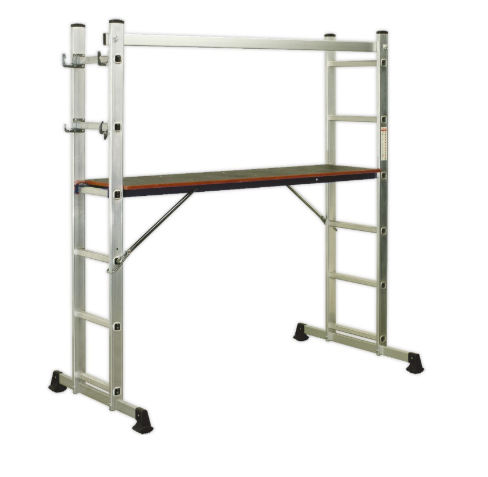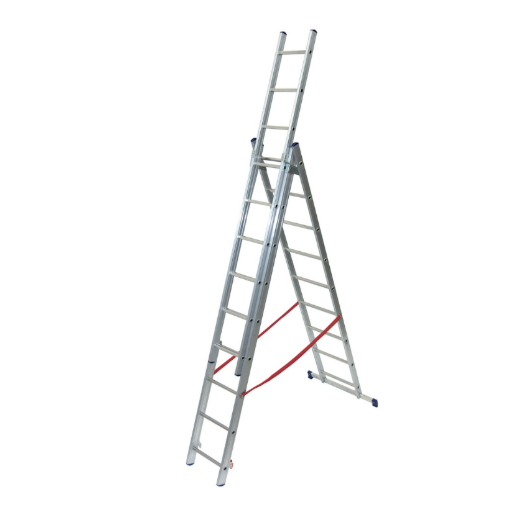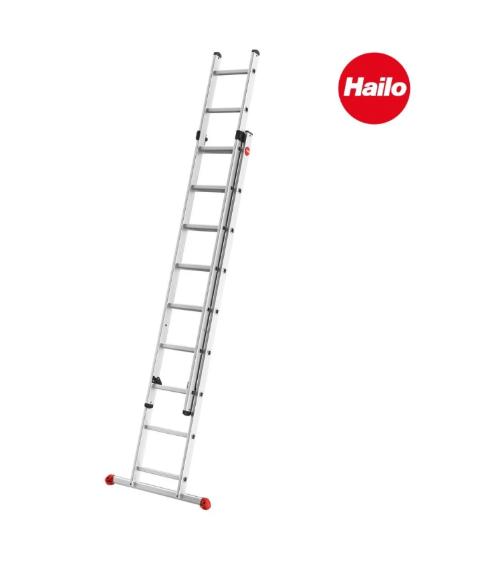There are many types and sizes of steps and ladders available, and it is important that you choose the right ones for the job. While the choice is vast, steps and ladders can be broken down into a number of distinct categories that can help you to narrow your search:
Step ladders
These are your everyday household ladders. They tend to be shorter in height and are useful for reaching high cupboards and for decorating standard sized rooms. Step ladders often have wider steps for safety and are self-supporting for greater stability. You can purchase step-ladders in a variety of heights, usually up to around 8 feet. Step-ladders fold away for easy storage when not in use and come in a range of materials, including metal, timber and glass fibre, rated to support varying weights.
- Ideal for everyday use
- Self-supporting
- Lightweight and easy to store
Straight ladders
These ladders are single-section so have a fixed height and are not self-supporting, meaning they need to be carefully propped against a wall when in use. Safety features such as rubber feet that don’t slip are worth looking for and they also come in outdoor and indoor varieties. They are usually constructed from light, hard-wearing materials so that they can be carried with one arm, and are ideal for general purpose use.
- Easy to transport
- Safety features
- Hard-wearing for indoor or outdoor use
Extension ladders
Extension ladders are similar to straight ladders, but feature a telescopic function, meaning they can be extended to greater heights without compromising storage space. These are not self-supporting so need to be secured against a wall, but are ideal for high jobs like working on a roof, cleaning top floor windows or decorating higher rooms. Their full heights vary and require safe working; the top three rungs are not for standing on as your stability would be compromised. Modern models are very easy to extend, with a smooth, sliding mechanism, and yet will remain solidly rigid when in use.
- Telescopic for a variety of heights
- Mainly commercial use
- Lock in place for safety
Mobile steps
Mobile steps are used solely in commercial environments, as their bulky construction and functions rarely suits the home. Fixed on spring-loaded casters that lock in place when a load is applied, they are ideal for industrial use where ladders will be moved around frequently. They typically come with guard rails for extra security and are usually made from high-grade, heavy-duty materials for increased stability and durability.
- Industrial use
- Easy to manoeuvre
- Spring-loaded casters lock in place
Loft ladders
These are specifically for use to access lofts and attics and are generally collapsible to be fitted inside the loft door. They will be supplied with hinges or sliders that allow the ladder to fold back up into the loft when not in use. They maximise space by being stored in the loft area, and because they fold away neatly, allowing you to keep the attic door closed, they also minimise heat loss. Loft ladders are available in extendable straight ladder styles or in concertina style, and are usually manufactured in either metal or timber.
- Fold away neatly
- Maximise space
- Minimise heat loss
Step stools
These are the most practical steps for everyday use in the workplace or home where just a small boost in height is required. They usually have only two to four rungs with a wide footprint for stability, and some models can be neatly folded away or nested so they only take up a minimum of storage space. Step stools or kick steps can be useful for retail stores, where some products are kept at higher levels, or in low level warehouses, office storage rooms and other areas where a higher reach is needed.
- Practical for everyday use
- Easy to store away
- Wide rungs for safety
Scaffolding
Scaffolding is used primarily in commercial work, whether construction or painting. They often come with two fixed sets of ladders on each side and a varying number of platforms between them. Many scaffold ladders are customisable in a variety of configurations and have handrails and non-slip platforms for safety. Some of them come with wheels for mobility while others are fixed structures. You can also choose mobile access towers that have a smaller overall footprint with a higher reach.
- Commercial outdoor use
- Safety features for working at height
- Usually customisable
Combination ladders
Combination ladders are customisable for a variety of uses. Using the latest technology, they can be reconfigured to act as a number of other types of ladder. Configurations include straight ladder, step ladder and sawhorse ladder, making this a fantastic choice if you have a number of regular needs. Many of the recent models come with a flared base that offers ever greater stability. While the initial outlay can be costlier, these ladders are usually more economical in the long run as they reduce the need for multiple types of ladders. They are also easy to store as they are telescopic.
- Re-configurable for a variety of uses
- Economic over time
- Easy to store
Roof ladders
As the name suggests, roof ladders are designed for the sole purpose of working on roofs. They are usually extendable and have hooks at the top that will reach over the edge of the roof and secure the ladders. Some styles have weight distribution measures to prevent damage to roofs and have safety catches for added security. They are practical and safe, and ideal if you do a lot of roof work. You can also purchase roof hook kits that allow you to adapt extendable ladders for this use.
- Safe working
- Weight distribution
- Conversion kits available
Work platforms
Also known as sawhorse ladders, these platforms are short in height and are generally used for odd jobs or for low-level commercial tasks. They fold away into a compact size for easy storage and are sturdy, with non-slip platforms and rubber feet. Work platforms are lightweight which makes them easy to carry around and have locking hinges for extra safety. Some models come with a built-in extendable plastic tray that reaches closer to your standing height to prevent bending to pick up tools.
- Lockable hinges for safety
- Compact, foldaway size
- Extra features available
Types of material
Ladders come in three basic material choices: aluminium, fibreglass and wood (usually, but not always timber). Choosing the right material depends on the job and also long-term requirements.
Aluminium
Aluminium ladders are non-corrosive, making them ideal for outdoor work. Naturally resistant to moisture, ladders made from this material will last for a long time, even if they’re occasionally left outside. They are also very light compared to wooden ladders, so are easier to move around from place to place, even in larger sizes. Their incredible strength means you won’t have to worry about a rung snapping or bending, unless excessive force is applied (and it would need to be very excessive; aluminium is an alloy designed for its strength above all else).
Wood
Wood is often chosen for its aesthetic qualities as it tends to fit in well with home décor and has a natural feel. Because it can be easily cut to size, wood is also an excellent material for custom ladders that are purpose-built for a specific job. However, they do require more maintenance than other materials, including treatment and staining, especially for outside use. Without this care, the wood can become brittle and crack, risking accident and injury. While there are still many reasons to choose wood, most people opt for aluminium.
Fibreglass
Fibreglass has many qualities that make them a great choice for particular types of tasks. They are even more durable than aluminium and can be left outdoors for long periods of time, as they will not rust, become brittle or otherwise start to decay. As they are non-conductive, they can also be used around power lines or when electrical tools are in use. Fibreglass is also flame resistant and so is an ideal choice when working around flames or heat. This material will not heat up like aluminium does, which makes them ideal for industrial use. However, they do tend to be more expensive to purchase than aluminium counterparts, and are significantly heavier to move around too.
Height
Getting the right length of ladder is crucial. Too long or too short and you risk losing balance, falling and injuring yourself. If the ladder extends more than three feet beyond its uppermost support point, it is too long. If you have to stand on or above the first step from the top rung of a step ladder or the third from the top of an extension ladder, it’s too short.
Make sure you choose the height carefully, particularly with a fixed-length ladder. For a good balance between ease of storage and a comfortable working height, opt for an extension ladder that will reach well beyond your maximum height. For even more flexibility, a multi-position ladder which allows for use in a variety of situations is a great all-round choice. Above all, be safe; if the ladder you own is forcing you to be in an insecure position, you need to trade up.
Ladder FAQs
Your questions answered…..
What sort of ladder platform do you need when painting the outside of a house?
When painting the exterior of a house, there are a number of different ladders that you can use for height access. A ladder scaffold is most likely going to be the most beneficial for the job. This features two straight ladders either side of a platform that stretches between the two sides. Whilst painting the outside of a property, you can stand on the platform rather than the ladder steps, without having to hold on for support, freeing up your hands for the painting. This also provides a more stable surface to work from than a regular ladder.

What size step ladder is best for cutting a 2 metre hedge?
When choosing a ladder size for a hedge, aim for a design that reaches slightly higher than the hedge. This way you can see over the top of the hedge and you have a better view of what you are cutting. When cutting or trimming anything outdoors, it is advised that you opt for a tripod style ladder or a combination ladder which allows for two bases (or four feet) to be on the floor at all times. This is a much safer option and provides extra stability when trimming or cutting a hedge. Do not lean a regular ladder against the hedge or bush. This is highly dangerous and is not advisable.

Why is an aluminium extension ladder better than wood?
An aluminium extension ladder offers a number of advantages. Less maintenance is required with an aluminium ladder as they don’t rust or corrode, plus they are lightweight yet highly durable. It is also a material that offers great stability and safety, which are key factors when choosing access equipment. An aluminium ladder may cost slightly more than a wooden one, but can last a lifetime if looked after properly.

Still not sure which type of ladder you require? Speak to one of our team members for more product information. We can provide in-depth knowledge on all of our access equipment, allowing you to find the right supplies for your workplace.
Related Articles:
Ladder Safety In The Workplace
